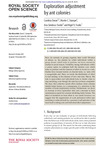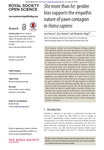Search
Now showing items 1-10 of 57
Discrete but variable structure of animal societies leads to the false perception of a social continuum
(2016)
Animal societies are typically divided into those in which reproduction within a group is monopolized by a single female versus those in which it is shared among multiple females. It remains controversial, however, whether ...
Artificial light onwater attracts turtle hatchlings during their near shore transit
(2016)
We examined the effect of artificial light on the near shore trajectories of turtle hatchlings dispersing from natal beaches. Green turtle (Chelonia mydas) hatchlings were tagged with miniature acoustic transmitters and ...
Responsiveness to conspecific distress calls is influenced by day roost proximity in bats
(2016)
Distress calls signal extreme physical distress, e.g. being caught by a predator. In many bat species, distress calls attract conspecifics. Because bats often occupy perennial day-roosts, they might adapt their responsiveness ...
Signalling with a cryptic trait
(2016)
Sexual signals often compromise camouflage because of their conspicuousness. Pigmentation patterns, on the contrary, aid in camouflage. It was hypothesized that a particular type of pattern—barred plumage in birds, whereby ...
Teaching in hunter– gatherer infancy
(2016)
A debate exists as to whether teaching is part of human nature and central to understanding culture or whether it is a recent invention of Western, Educated, Industrial, Rich, Democratic cultures. Some social–cultural ...
High atmospheric temperatures and ‘ambient incubation’ drive embryonic development and lead to earlier hatching in a passerine bird
(The Royal Society, 2016)
Tropical and subtropical species typically experience relatively high atmospheric temperatures during reproduction, and are subject to climate-related challenges that are largely unexplored, relative to more extensive work ...
Trophic niche divergence among colour morphs that exhibit alternative mating tactics
(2016)
Discrete colour morphs associated with alternative mating tactics are assumed to be ecologically equivalent. Yet suites of behaviours linked with reproduction can also favour habitat segregation and exploitation of different ...
Exploration adjustment by ant colonies
(2016)
How do animals in groups organize their work? Division of labour, i.e. the process by which individuals within a group choose which tasks to perform, has been extensively studied in social insects. Variability among ...
She more than he: gender bias supports the empathic nature of yawn contagion in Homo sapiens
(2016)
Psychological clinical and neurobiological findings endorse that empathic abilities are more developed in women than in men. Because there is growing evidence that yawn contagion is an empathy-based phenomenon, we expect ...
Lack of experience based stratification in homing pigeon leadership hierarchies
(2016)
In societies that make collective decisions through leadership, a fundamental question concerns the individual attributes that allow certain group members to assume leadership roles over others. Homing pigeons form transitive ...










